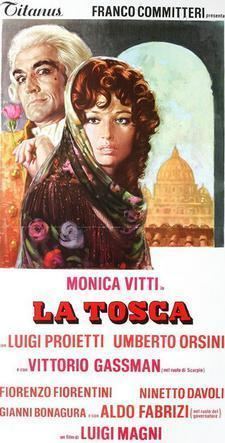7.2 /10 1 Votes
3.7/5 Comingsoon Produced by Ugo Tucci Cinematography Franco Di Giacomo Director Luigi Magni Screenplay Luigi Magni | 7.2/10 IMDb Directed by Luigi Magni Music by Armando Trovajoli Initial release 23 March 1973 Music director Armando Trovajoli Story by Victorien Sardou | |||||||||||||||||||||||||||||||||
 | ||||||||||||||||||||||||||||||||||
Written by Victorien Sardou (play), Luigi Magni (story and screenplay) Starring Monica Vitti, Gigi Proietti, Vittorio Gassman, Aldo Fabrizi Cast Monica Vitti, Gigi Proietti, Vittorio Gassman, Aldo Fabrizi Similar Scipio the African, The Conspirators, In the Name of the Pope, Faustina, Basta che non si sappia in | ||||||||||||||||||||||||||||||||||
La tosca chi so so tutta un fo co m madre morta tisica
La Tosca (also known as Tosca) is a 1973 Italian comedy-drama film written and directed by Luigi Magni. It is loosely based on the drama with the same name by Victorien Sardou, reinterpreted in an ironic-grotesque style.
Contents
- La tosca chi so so tutta un fo co m madre morta tisica
- Canto dei derelitti la tosca luigi magni uaacs antireligione
- Plot
- Cast
- References
Canto dei derelitti la tosca luigi magni uaacs antireligione
Plot
Rome, 14 June 1800. Napoleon's army threatens to conquer Italy, including the Papal States. Rome is reeking with corruption, especially among the clergy, determined to retain their privileges based on the exploitation of the poor ignorant people.
The fugitive patriot Cesare Angelotti, escaped from Castel Sant'Angelo, is sheltered by painter Mario Cavaradossi. Baron Scarpia, regent of the Pontifical Police, hunts him down by duping Floria Tosca, Cavaradossi's mistress, into thinking that her lover is cheating on her. The woman, trailed by Scarpia, heads for Cavaradossi's house, hoping to catch him in the act, but finds him instead in Angelotti's company. Realizing she's been deceived, Tosca tries her best to save her lover, but it is too late. Scarpia reaches the house and surprises Angelotti, who commits suicide rather than being taken in.
Scarpia then arrests the painter for high treason, a capital offense. Lusting after Tosca, the baron blackmails her: he will have the painter freed if she yields to his sexual advances. She accedes, whereupon he makes a show of ordering his minions to have the painter shot with blanks. The letter of safe conduct written, Scarpia is then stabbed in the back by Tosca, who then bolts off to Castel Sant'Angelo to be reunited with her lover. However, Cavaradossi is executed for real, and Tosca, in despair, throws herself off the ramparts of the castle and commits suicide.
Life in Rome continues seemingly unchanged, with the clergy oblivious to the new times looming, and the changes about to overtake the world.
